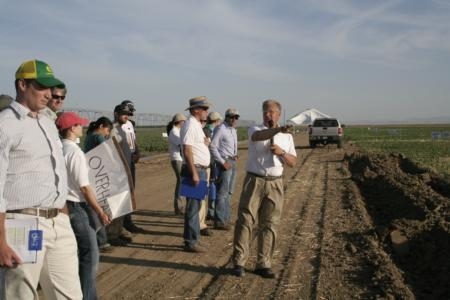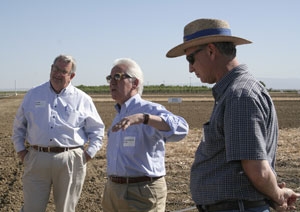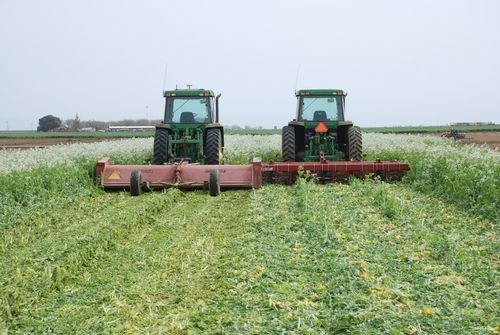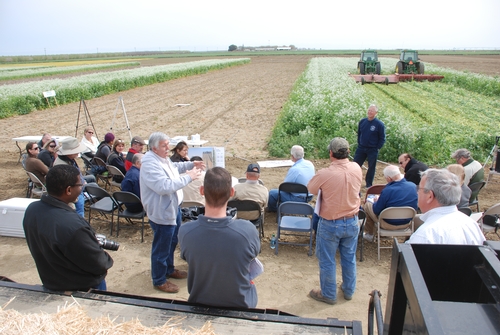Conservation agriculture news
Second annual *twilight* conservation tillage field day
The Conservation Tillage and Cropping Systems Institute will hold its second annual twilight field tour and barbecue from 4 to 7 p.m. Thursday, Sept. 8, at the UC West Side Research and Extension Center, 17353 W. Oakland Ave., Five Points.
Participants will learn how San Joaquin Valley farmers are using overhead, mechanized, automated irrigation and conservation tillage to cut production costs. Overhead irrigation and conservation tillage also have the potential to improve soil quality, save water and cut back on agricultural dust emissions.
The late afternoon program will include research updates on trials with wheat, corn, tomatoes, onions, cotton and broccoli. Industry presenters will discuss the basics of water delivery devices and initial design and operation considerations for center pivot irrigation systems. Updates on the profitability and impacts of conservation tillage cotton and tomato production systems on soil properties will also be provided by UC and CSU Fresno researchers.
During the barbeque dinner, recipients of the 2011 Conservation Tillage Farmer Innovator Awards will be announced. This year’s session will also feature a number of awards for private sector innovation in CT and irrigation. A farmer panel composed of Armando Galvan, Darrell Cordova, Scott Schmidt and John Diener will discuss recent farm experiences with overhead irrigation and the evening will wrap up with a farm visit to one of the pivots of Scott Schmidt at Farming ‘D.’
For more information, contact institute chair Jeff Mitchell at mitchell@uckac.edu.
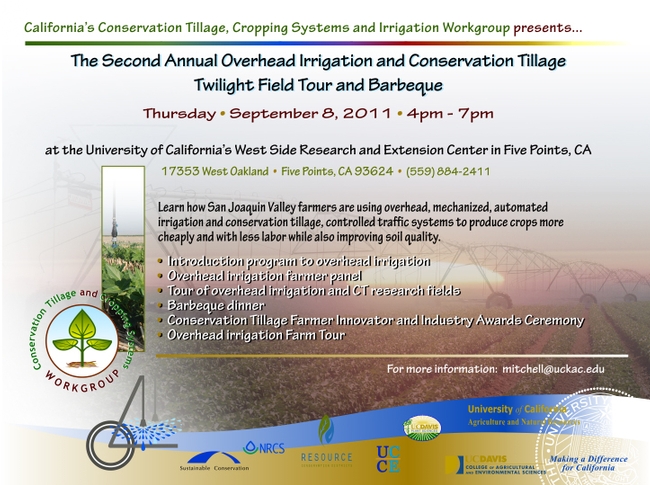
JM TwilightBBQ2011
CT research compares subsurface drip with overhead irrigation
The Conservation Tillage workgroup has initiated a long-term study that directly compares the use of subsurface drip irrigation and overhead irrigation in a diverse no-till crop rotation. The drip lines are buried 10 to 12 inches deep, which will allow the scientists to experiment with a number of different crops over the next 6 or 7 years.
"We're trying to look at the flexibility of flat planting, diversity in cropping and drip irrigation, which is becoming the standard in many crops, and comparing this with overhead, automated mechanized irrigation," said workgroup chair Jeff Mitchell, UC Cooperative Extension cropping systems specialist. "We want to study what the future is going to be."
Currently, nearly all the Central California acreage of processing tomatoes is drip irrigated; cotton, in contrast, is still mostly grown with furrow irrigation. An increasing amount of acreage is also being irrigated with overhead, mechanized irrigation systems in recent years. In addition to cotton and tomatoes, the researchers plan to grow onions, broccoli and wheat on the plots.
Farmers visited the site of the new research during a workgroup meeting June 28 at the UC West Side Research and Extension Center near Five Points. At the first stop, the researchers introduced growers to conservation tillage research that compares no-till cotton and tomatoes planted in the residue of cover crops with crops grown using standard practices. These plots are furrow irrigated.
Data about soil surface water evaporation, soil temperature variances, nutrient differences, weed management, plant growth and yield are being collected.
In addition to generating data about the use of conservation tillage in California production systems, the CT workgroup encourages farmers to try conservation tillage in their own operations.
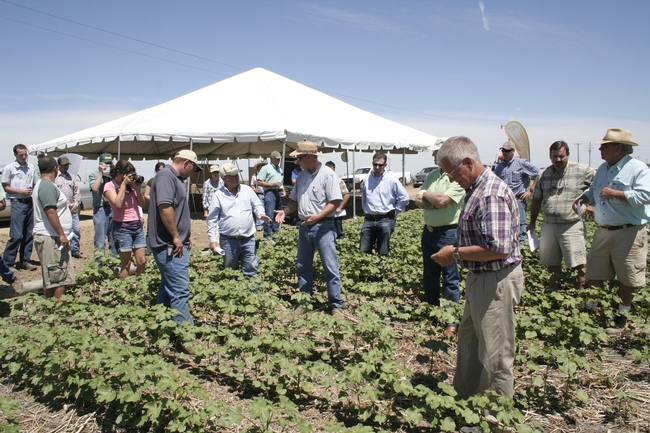
Jeff Mitchell, in the foreground, addresses participants from a conservation tillage research plot.
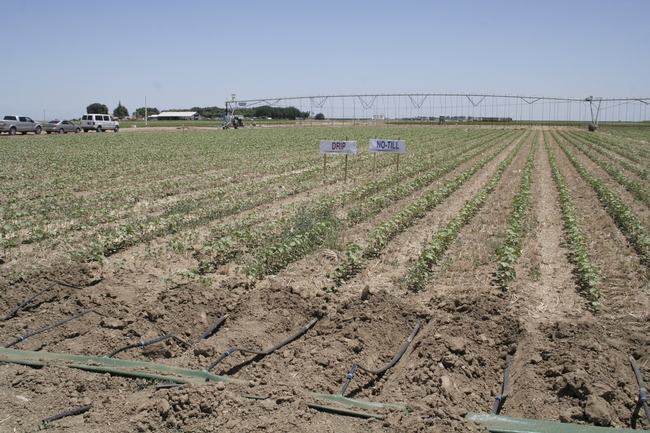
Drip-irrigated conservation tillage plots will be managed side-by-side with overhead-irrigated plots.
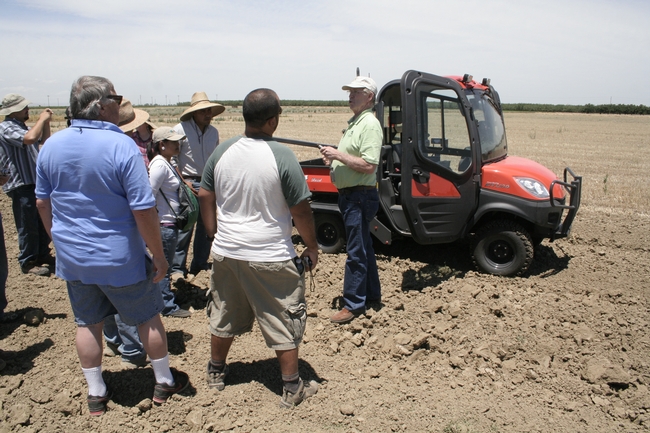
Jim Burton of AgRobotics Farming Innovations explains his invention, which makes soil sampling fast and easy.
Congressman Costa visits CT workgroup
United States Congressman Jim Costa met with the Conservation Tillage and Cropping Systems Workgroup at the UC West Side Research and Extension Center on April 27. During the meeting, he voiced his support for increasing implementation of conservation tillage farming systems. Costa is a member of the House Committee on Agriculture, which is laying the groundwork for the reauthorization of the Farm Bill in 2012.
Workgroup member Ron Harben, air quality planner and coordinator with the California Association of Resource Conservation Districts, asked the congressman for $5 million over five years to study the adoption process and fund CT extension activities.
Harben suggested U.S. representatives create a California agriculture caucus in order to work together to ensure the state, the No. 1 ag producer in the nation, gets its fair share of federal support for agricultural programs.
Costa said he liked the idea of establishing a California ag caucus.
"The question is how to put it together without it becoming political," he said. "We had such a caucus with 21 bipartisan members. It worked pretty well for a number of years."
Congressman Jim Costa comments about conservation tillage in this 90-second video.
Jeff Mitchell touts CT on KMJ radio
UC Davis cropping systems specialist Jeff Mitchell appeared a Fresno morning ag show on KMJ 580 am radio. The radio story is archived online, about midway through the hour-long broadcast.
Mitchell conducted a phone interview with host Sean Michael Lisle in which he said national experts on no-till and strip-till came to California to encourage the state's farmers to try conservation tillage, which can conserve water, suppress dust, reduce runoff, lower labor costs, save fuel and sequester carbon.
"There is a growing interest now in these kinds of systems that potentially can reduce production costs and can have a number of adjunct benefits associated with them, and that would be quite new for California," Mitchell said on the program. "Currently in California, very little of the annual crops, row crops, field crops are grown with these kinds of practices."
Mitchell said the dairy industry has been particularly receptive to the idea.
"Our workgroup has documented some rather significant changes in tillage practices in the last 6 years," Mitchell said. "The adoption of these kinds of practices has actually gone up to about 20 percent of the acreage from about 2 percent in that time period."
Cover crops: What goes around comes around
Cover crops, or vegetation that was grown after the cash crop was harvested, was a practice that was widely used in the 1940s and 1950s. The vegetation was used to maintain or increase the fertility of the soil before commercial fertilizers became widely available. The cover crops also provided organic matter to the soil that was necessary to keep the soil easy to plow. When commercial fertilizers became more widely used, cover crops faded from the agricultural picture.
Cover crops are making a comeback of sorts due to the depletion of the organic matter over the intervening decades of intense farming as well as farmers taking advantage of a cover crop’s environmental benefits. A winter cover crop can add back to the soil the organic matter that was lost due to farming practices as well as take up the fertilizer left over from the previous crop that can potentially leach into the ground water or runoff in storm water. A well-managed cover crop can also provide needed protection from raindrop impact that can cause a crust to form on the surface of the soil that further reduces water penetration and adequate air movement through the soil. The vegetation can also keep soil moisture from evaporating when young crops need it most.
To help farmers learn more about the “lost art of cover cropping” and to see actual cover crop management techniques up close and personal, the University of California’s Conservation Tillage and Cropping Systems Workgroup conducted an interactive field day on March 18 at the West Side Research and Extension Center in Five Points, Calif. The session came on the heels of a three-day conference series the previous week that provided examples of successful high-residue cropping systems that also use cover crops from other irrigated regions of the U.S.
The backdrop for the field day was a field that has been comparing no-till cotton and tomato production techniques for the last eight years. Comparisons between crops grown with and without winter cover crops have been measured against current standard “clean cultivation” management in which no cover crop is used. Also compared was a standard tillage system in which winter cover crops are “green manured” or incorporated into the soil in the spring before the next crop is planted.
UC Davis researcher, Jeff Mitchell, reported that about two tons of cover crop dry matter - of which roughly 40 percent is carbon and 2 percent is nitrogen - has been produced in the cover crop plots each year with winter rainfall and no supplemental irrigation. These cover crops resulted in a 22 percent increase in soil carbon in the green manured, standard tillage system, and an even higher 29 percent increase in soil C in the no-till cover crop system following the eight years of study.
From year to year, the water available for agriculture can vary greatly so cover crops must be able to “work their magic” with little or no increased water requirements. Because wintertime temperatures are lower and the humidity is generally higher, evapotranspiration (ET) - or the water that both evaporates from the soil and water that is used by plants - during the winter growing period tends to be much lower than in summer. However, a winter-growing cover crop is using water that would normally be available to a spring-planted crop. Therefore, farmers need to weigh the many advantages of a cover crop with the potential disadvantage of its winter water use.
Mitchell’s monitoring of the top foot of soil three days before the field day indicated about 3 inches of water in the fallow plots with only about 2.5 inches in the cover crop plots. The cover crop that Mitchell used this year consisted of Tillage Radish™, forage pea, and Phacelia, and had produced about 7,000 pounds of dry matter per acre at the time of the field day.
The field day also featured Greg Wittenborn of Lockwood Seed and Grain of Chowchilla, Calif., and Chuck Cambra and Tom Johnson of Kamprath Seed in Manteca, Calif. The trio provided information on cover crop seed costs, the importance of selecting cover crop materials, and designing cover crop strategies to achieve specific cropping goals. Many cover crop species and mixes are now commercially available to address a farmer’s specific needs.
Additional information on cover crops will be posted at the Workgroup’s website http://ucanr.org/sites/ct/ and opportunities for viewing other field operations related to cover cropping will be publicized via the Workgroup’s email announcement service. To become involved with the Conservation Tillage and Cropping Systems Workgroup, contact workgroup chair Jeff Mitchell at mitchell@uckac.edu.
Two of the methods for terminating cover crops that were demonstrated at the cover crop field day in Five Points, Calif. On the left is a conventional flail mower that flail chops standing cover crop materials leaving very small pieces of shredded above-ground material. On the right is a cover crop stalk chopper that is ground-driven and chops standing cover crops leaving 7- to 8-inch pieces of above-ground matter. (Photo by Ron Harben.)
Chuck Cambra of Kamprath Seed Company in Manteca, Calif., (in gray sweatshirt at center-left of photo) addressing participants of the cover crop field day held in Five Points, Calif., on March 18. (Photo by Ron Harben.)

